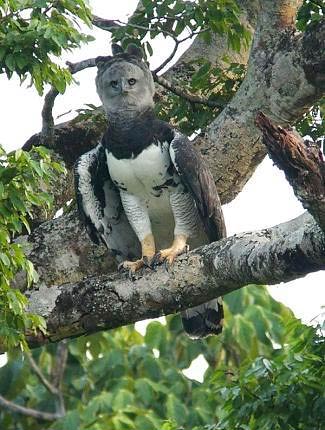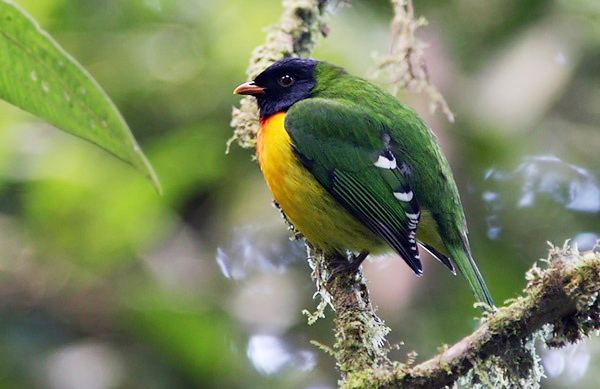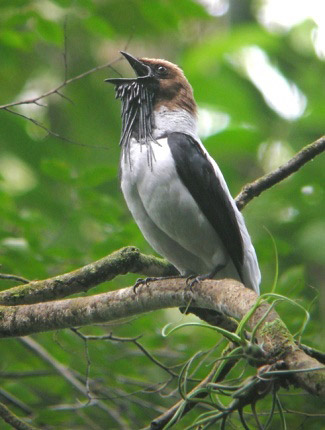

Harpy Eagle by Chris Townend.
- A good chance of Harpy Eagle
- A cave with thousands of Oilbirds
- One of the best selections of the best-looking cotingas in the world, including Guianan Cock-of-the-rock, Capuchinbird, Pompadour, Purple-breasted and Spangled Cotingas, Bearded and White Bellbirds, Handsome and Red-banded Fruiteaters, and Rose-collared Piha
- Lots of other Guiana Shield Endemics such as Tepui Goldenthroat, Peacock Coquette, Scarlet-horned Manakin, Tepui Whitestart and Golden-tufted Mountain Grackle
- And some of South America’s and the world’s other most spectacular birds including American Flamingo, Scarlet Ibis, Red-and-green Macaw, Hoatzin, hummingbirds such as Crimson and Ruby Topazes, and Black-eared Fairy, jacamars, toucans, White-plumed Antbird and Paradise Tanager
- And Angel Falls, the highest waterfall in the world
- All in some superb forests
- In October 2021 the British Foreign and Commonwealth Office (FCO) continued to advise against all travel to within 80 km (50 miles) of the Colombian border and 40 km (25 miles) of the Brazilian border, and against all but essential travel to the remaining areas of Venezuela due to ongoing crime and instability.
- If time allows it may be worth also visiting the lowland forests around the remote Camani Lodge in Amazonas, southern Venezuela, where Giant Otter and Pink River Dolphin occur, as well as many birds including Scarlet and Red-and-green Macaws, Grey-winged Trumpeter, Agami Heron, Amazonian Umbrellabird and White-browed Purpletuft. There is even a chance of the rarely seen Rufous-winged Ground-cuckoo.
- In Western Venezuela it is possible to see mammals such as (Brown-throated) Three-toed Sloth, Capybara, Red Howler Monkey, Grey River Dolphin and, possibly, Giant Anteater, Southern Tamandua, Pink River Dolphin, Ocelot and Brazilian Tapir, and many spectacular birds including Scarlet Ibis, Sunbittern, Scarlet Macaw, Yellow-knobbed Curassow, Bearded Helmetcrest, Crested, Golden-headed and White-tipped Quetzals, Andean Cock-of-the-rock and Wire-tailed Manakin.
Best Birds and other wildlife in East Venezuela
Birds
Endemics - 58 - not all of these occur in the east.
(Six hummingbirds, five antpittas and a fruiteater)
North/Northwest 36
Venezuelan Wood-quail, Merida Sunangel, White-bearded Helmetcrest, Golden (Golden-bellied) Starfrontlet, Green-tailed Emerald, Rusty-flanked Crake,
Plain-flanked Rail (small range), Groove-billed Toucanet, Venezuelan Parakeet, Red-eared Parakeet, Rose-headed Parakeet, Great Antpitta (probably also
occurs in Colombia), Grey-naped Antpitta, Scallop-breasted Antpitta, Merida Tapaculo, Caracas Tapaculo, Guttulate Foliage-gleaner, Ochre-browed
Thistletail, Black-throated Spinetail, Handsome Fruiteater, Rufous-lored Tyrannulet, Venezuelan Bristle-tyrant, Maracaibo Tody-flycatcher, Venezuelan
Tyrannulet, Blackish (Slaty-backed) Chat-tyrant, Rufous-browed (Brown-backed) Chat-tyrant, Merida Wren, Caracas Brush-finch, Merida (Moustached)
Brush-finch, Green-billed (Russet-backed) Oropendola, White-fronted Whitestart, Slaty-backed Hemispingus, Grey-capped Hemispingus, Merida Flowerpiercer,
Rufous-cheeked Tanager and Chestnut-breasted (Golden) Tanager.
West 1 Tachira Antpitta (small range).
Northeast/Paria Peninsula 13 Venezuelan Sylph (Cordillera de la Costa), Scissor-tailed Hummingbird (Paria), Black-spotted Piculet, White-throated Barbet (Serrania de Turimiquire and Cordillera de Caripe), Paria (White-throated) Barbet, Sucre Antpitta (also Paria Peninsula), White-throated Barbtail, Paria Barbtail, Urich’s Tyrannulet (first described in 1899, seen in the 1940s then in 2005, and then again in 2021 in cloud forest at Yucucual-Mata de Mango), Paria Brush-finch, Grey-headed Warbler (Cordillera de Caripe), Paria Whitestart and Venezuelan Flowerpiercer.
South 6 Tepui Tinamou (small range), Tepui (Band-winged) Nightjar, Orinoco Softtail (small range), White-faced Whitestart (Cerros Guanay, Sipapo and Yavi), Guaiquinima Whitestart (small range) and Duida Grass-finch (small range).
East - Lower Rio Caroni 1 Carrizal Seedeater (Isla Carrizal in the lower Caroni River, Bolivar. Three specimens found in 2001; the only known habitat, stands of spiny Guadua and Ripidocladus species of bamboo, has been cleared to allow construction of the Tocoma Dam, but researchers are hopeful of finding the birds living elsewhere).
East - Orinoco Delta 1
Near-endemics - not all in the east.
Venezuela and Colombia 81 (16 hummingbirds, three puffbirds and three antpittas) Rufous-vented Chachalaca, Yellow-knobbed Curassow, Helmeted Curassow, Black-fronted Wood-quail, Northern Screamer, Bare-eyed Pigeon, Pygmy Swift, Orange-throated Sunangel, Longuemare’s (Amethyst-throated) Sunangel, Perija Metaltail, Coppery-bellied Puffleg, Green (Collared) Inca, Perija (Golden-bellied) Starfrontlet, Blue-throated Starfrontlet, Red-billed Emerald, Coppery Emerald, Narrow-tailed Emerald, Short-tailed Emerald, Buffy Hummingbird, Steely-vented Hummingbird, Green-bellied Hummingbird, Shining-green Hummingbird, Violet-chested Hummingbird, Dwarf Cuckoo, White-tipped Quetzal, Pale-headed Jacamar, Russet-throated Puffbird, Two-banded (Russet-throated) Puffbird, Moustached Puffbird, Citron-throated (Channel-billed) Toucan, Yellow-billed (Groove-billed) Toucanet, Scaled Piculet, Chestnut Piculet, Rusty-faced Parrot, Perija (Painted) Parakeet, Scarlet-fronted Parakeet, Recurve-billed Bushbird, Streak-fronted (Black-crested) Antshrike, Bar-crested Antshrike, Black-backed Antshrike, Klages’s Antbird, Magdalena Antbird, Blue-lored Antbird, Perija (Rufous) Antpitta, Hooded Antpitta, Rusty-breasted Antpitta, Perija Tapaculo, Pale-bellied Tapaculo, Scalloped (Schwartz’s) Antthrush, Eastern Barred Woodcreeper, Caribbean (Pale-legged) Hornero, Plain (Rufous-fronted) Thornbird, Perija Thistletail, Streak-capped Spinetail, Crested Spinetail, White-whiskered Spinetail, Orinoco Spinetail, White-bibbed Manakin, Golden-breasted Fruiteater, Mountain (Spectacled) Tyrannulet, Slender-billed Tyrannulet, White-bearded Flycatcher, Scrub Greenlet, Black-collared Jay, Stripe-backed Wren, Black-billed Thrush, Tocuyo Sparrow, Perija Brush-finch, Yellow-mandibled (Pectoral) Sparrow, Golden-winged Sparrow, Ochre-breasted Brush-finch, Black-fronted (Yellow-breasted) Brush-finch, Grey-throated Warbler, Yellow-crowned (Golden-crowned) Warbler, Yellow-fronted Whitestart, Vermilion Cardinal, Orinocan Saltator, Fulvous-headed Tanager, Rufous-browed Conebill, Glaucous Tanager and Black-headed (Hooded) Tanager.
Venezuela, Colombia, and Trinidad & Tobago 6 Rufous-shafted Woodstar, Stripe-breasted Spinetail, Venezuelan Flycatcher, Trinidad Euphonia, Venezuelan Troupial and Masked Cardinal.
Venezuela, Colombia and Guyana 2 Northern Festive Parrot and Red Siskin.
Venezuela, Colombia and Guianas 1 Lilac-tailed Parrotlet.
Venezuela, Colombia and Brazil 7 Orinoco Piculet, Yapacana Antbird, Grey-bellied Antbird, Yellow-throated Antwren, Brown-headed Greenlet, Azure-naped Jay and Rio Negro Gnatcatcher.
Venezuela, and Trinidad & Tobago 1 Copper-rumped Hummingbird.
Venezuela and Tobago 1 White-tailed Sabrewing.
Venezuela and nearby islands 1 Yellow-shouldered Amazon (Venezuelan islands of Margarita and La Blanquilla, and the island of Bonaire in the Caribbean. It has been extirpated from the islands of Aruba and possibly also Curacao.)
Venezuela and Guyana 2 Fiery-shouldered Parakeet and Red-banded Fruiteater.
Venezuela, Guyana and Suriname 2 Blue-cheeked Amazon and Guianan (Rufous-brown) Solitaire.
Venezuela, Guyana and Brazil 35 Roraiman Nightjar, Tepui Swift, Tepui Goldenthroat, Peacock Coquette, Velvet-browed Brilliant, Rufous-breasted Sabrewing, Copper-tailed (Green-bellied) Hummingbird, Tepui Parrotlet, Roraiman Antwren, Streak-backed Antshrike, Roraiman Antbird, Tepui Antpitta, White-throated Foliage-gleaner, Roraiman Barbtail, Tepui Spinetail, Olive Manakin, Scarlet-horned Manakin, Orange-bellied Manakin, Rose-collared Piha, Green-cheeked (Green-backed) Becard, Black-fronted Tyrannulet, Chapman’s Bristle-tyrant, Sierra de Lema (McConnell’s) Flycatcher, Ruddy Tody-flycatcher, Tepui Elaenia, Flutist Wren, Tepui Wren, Pantepui (Black-billed) Thrush, Tepui Brush-finch, Golden-tufted Grackle, Roraiman (Two-banded) Warbler, Tepui Whitestart, Olive-backed Tanager, Greater Flowerpiercer and Black-hooded Tanager.
Venezuela, Guianas and Brazil 36 Guianan Puffbird, Tepui Toucanet, Guianan Toucanet, Green Aracari, Black-spotted Barbet, Caica Parrot, Painted Parakeet, Northern Red-shouldered Macaw, Brown-bellied Stipplethroat (Antwren), Spot-tailed Antwren, Todd’s Antwren, Black-throated Antshrike, Guianan Antwarbler (Warbling Antbird), Ferruginous-backed Antbird, Red-billed Woodcreeper, Chestnut-rumped Woodcreeper, Lineated (Guianan) Woodcreeper, McConnell’s Spinetail, Tiny Tyrant-manakin, Crimson-hooded Manakin, White-throated Manakin, Guianan Red Cotinga, White Bellbird, Dusky Purpletuft, Glossy-backed Becard, Olivaceous Schiffornis (Mourner), Smoky-fronted Tody-flycatcher, Painted Tody-flycatcher, Guianan Tyrannulet, Olive-crowned Greenlet, Tepui Vireo (not French Guiana), Cayenne Jay, Finsch’s Euphonia, Golden-sided Euphonia, Red-and-black Grosbeak and Blue-backed Tanager.
Venezuela and Brazil 6 Buff-breasted Sabrewing, Sapphire-spangled Emerald, Caura Antbird, Black-chested Tyrant, Great Elaenia (likely to occur in Guyana) and Scaled Flowerpiercer.
Other Specialities
Harpy Eagle, Rufous Crab-hawk, Red-and-green Macaw, Red-fan Parrot, Bearded Bellbird and Fulvous Shrike-tanager.
Others
Little and Rufous-vented Chachalacas, Spix's Guan, Horned Screamer, Muscovy Duck, American Flamingo, Capped Heron, Reddish Egret, Green and Scarlet Ibises,
Brown Pelican, Magnificent Frigatebird, Brown Booby, King Vulture, Slender-billed and Swallow-tailed Kites, hawks including White, Ornate Hawk-eagle,
Laughing Falcon, Grey-necked Wood-rail, Limpkin, shorebirds including Wattled Jacana, Black Skimmer, pigeons, doves, Chestnut-fronted and Red-shouldered
Macaws, parakeets such as Painted, parrots including Orange-winged and Yellow-shouldered, Squirrel Cuckoo, Burrowing Owl, Oilbird, Hoatzin, trogons,
hummingbirds including Crimson and Ruby Topazes, and Black-eared Fairy, all five South American kingfishers, Brown, Great, Green-tailed, Paradise and
Rufous-tailed Jacamars, puffbirds including Two-banded and Russet-throated, Swallow-wing, Black-spotted Barbet, Black-necked Aracari, Chestnut-tipped
Toucanet, Channel-billed and Red-billed (White-throated) Toucans, woodpeckers, woodcreepers, antshrikes, antwrens, antbirds including Ferruginous-backed
and White-plumed, tyrannulets, Short-tailed Pygmy-tyrant (the smallest passerine in the world along with Black-capped Pygmy Tyrant), tody-tyrants,
tody-flycatchers including Spotted, flycatchers such as Cliff and Fork-tailed, Sharpbill, Screaming Piha, Purple-throated Fruitcrow, Pompadour,
Purple-breasted and Spangled Cotingas, Golden-headed Manakin, tityras, becards, Slaty-capped Shrike-vireo, Inca Jay, Musician Wren, Long-billed Gnatwren,
Black-capped Donacobius, Rufous-brown Solitaire, thrushes, Slate-throated Whitestart, Black-faced and Blue Dacnises, tanagers including Glaucous, Paradise,
Spotted and Turquoise, honeycreepers, Red-capped Cardinal, Crested and Green Oropendolas, Venezuelan Troupial, Oriole and Yellow-hooded Blackbirds, and
euphonias. Also a chance of Blue-and-yellow Macaw, White-tipped Quetzal and Rose-breasted Chat.
Mammals
Red Howler and Weeping Capuchin Monkeys. Also a chance of (Pale-throated) Three-toed Sloth and Red-rumped
Agouti.
Reptiles, Amphibians and Fish
A chance of Spectacled Caiman.
Other Natural Wonders in East Venezuela
Angel Falls
The highest waterfall in the world flows off the Auyan-Tepui, dropping a total of almost a kilometer
(979 m, 3212 ft), including 807 m (2648 ft) in one go; so high, most of the water dissipates or evaporates before reaching the river below. It
is usually at its best between May and September.
Tepuis
A few of about a hundred of the flat-topped, almost sheer-sided, sandstone mesas are visible from the Gran
Sabana above La Escalera. They rise as high as 2772 m (9094 ft) at Roraima on the Venezuela-Brazil-Guyana borders.
Best Sites for Birds and other wildlife in East Venezuela
- Northeast
- Araya Peninsula American Flamingo, Scarlet Ibis, Magnificent Frigatebird, Yellow-shouldered Parrot, Ruby Topaz, Buffy Hummingbird, Rufous-tailed Jacamar, Vermilion Cardinal and Glaucous Tanager.
- Cano Ajies Scarlet Ibis and Rufous Crab-hawk.
- Paria Peninsula NP (Cerro de Humo) White-tailed Sabrewing, Scissor-tailed Hummingbird, White-throated Barbtail, Sucre Antpitta, Handsome Fruiteater and Paria Whitestart. Also a chance of White-tipped Quetzal.
- Cueva de los Guacharos, Caripe Thousands, perhaps more than 10,000, Oilbirds, in a cave about 10 km (6 miles) long.
- Cerro Negro Venezuelan Sylph, White-tailed Sabrewing, White-throated Barbtail, Handsome Fruiteater, Grey-headed Warbler and Venezuelan Flowerpiercer.
- Cano Colorado near Rancho San Andres Black-dotted Piculet and Crimson-hooded Manakin.
- Boat trip along Morichal Largo into Orinoco Delta Rio Orinoco Spinetail, Delta Amacuro Softtail, Black-chested Tyrant and Crimson-hooded Manakin, as well as a possible unnamed species of wagtail-tyrant.

A superb male Handsome Fruiteater on Cerro de Humo by Lars Petersson.
- Southeast
- Imataca (Rio Grande) FR Harpy Eagle, Red-and-green Macaw, Red-fan Parrot, jacamars, Black-throated Antshrike, Ferruginous-backed, Rufous-throated and White-plumed Antbirds, Pompadour Cotinga, Purple-throated Fruitcrow, Cayenne Jay and Musician Wren. Also a chance of Black Curassow and Rose-breasted Chat.
- El Pauji Yellow-billed Jacamar, and Blue-crowned, Orange-bellied and Scarlet-horned Manakins.
- Las Claritas Black-eared Fairy, Crimson Topaz, Capuchinbird, Pompadour, Purple-breasted and Spangled Cotingas, Bearded and White Bellbirds, and Musician Wren. Also a chance of Blue-backed Tanager.
- La Escalera (Sierra de Lema) Guianan Cock-of-the-rock (Km 111), Pompadour Cotinga, Red-banded Fruiteater, Rose-collared Piha, Bearded and White Bellbirds, Olive and Scarlet-horned Manakins, Sharpbill, Tepui Foliage-gleaner, McConnell's Spinetail, Ruddy Tody-tyrant, Roraiman Antwren, Flutist Wren, Paradise Tanager, Greater Flowerpiercer, Roraiman Warbler, Tepui Whitestart and Golden-tufted Mountain Grackle. Also a chance of Peacock Coquette and (Pale-throated) Three-toed Sloth.
- Paraitepui village to Mount Roraima (mini-expedition) A chance of Tepui Parrotlet, Tepui Antpitta, Roraiman Barbtail, Tepui Foliage-gleaner, Great Elaenia, Rose-collared Piha, Red-banded Fruiteater, Tepui Wren, Tepui Whitestart and Greater Flowerpiercer.

Bearded Bellbird by Mark Harper.
Best Times for Birds and other wildlife in East Venezuela
There are no strict dry and wet seasons and it may rain at any time of the year but it is usually drier between October and April and this is the best time to look for birds, especially February-March. Angel Falls however is usually at its best between May and September, and may be little more than a comparative trickle at other times of the year.
Recommended Bird Books etc. for East Venezuela
Birds of Venezuela by D Ascanio, G Rodriguez and R Restall. Helm, 2017.
Field Guide to the Birds of Venezuela by S Hilty. Helm, 2002.
Birds of South America: Non-Passerines by J R Roderiguez Mata et al. Harper Collins, 2006.
Birds of South America: Passerines by R S Ridgely and G Tudor. University of Texas Press/Helm, 2009 (Updated paperback edition of books listed next with 400 more illustrations).
The Birds of South America: Passerines by R S Ridgely and G Tudor. University of Texas Press, 1989 and 1994 (Two volumes).
Birds of Northern South America by R Restall, C Rodner and M Lentino. Helm, 2006 (Two volumes).
Birding in Venezuela by M L Goodwin. Lynx Edicions, 2003 (Fifth Edition).
Wild Mammals of Venezuela by R D Lord. Armitano Editores, 2000.
Mammals of South America by R D Lord. Johns Hopkins University Press, 2007.
Apps etc.
All Birds Venezuela by Bloomsbury/Sunbird Images.
Where to watch birds in South America by N Wheatley. Helm, 1994.
Don’t know which country/countries to visit in South America? Then it may be worth considering taking a look at this book, written by this website’s author. It is many years old of course but it still provides a starting point, an overview and a guiding light to the best birds and the best places to look for them on the continent, and could save hours of searching for similar information on the internet. However, it is important to check more up-to-date sources for sites which have been opened up, sites and species which have been discovered, lodges that have been built etc. since the book was published.
Birding and Wildlife Trip Reports for East Venezuela
Many trip reports, some for Eastern Venezuela, are posted on the websites listed here. On some of these websites some reports are independent and some are posted by tour companies who organize tours to Eastern Venezuela. These tour companies and others also post their own reports on their websites, which are listed under 'Some Organized Tours to Eastern Venezuela' below.
- The best website for trip reports is CloudBirders
- but these are also worth a look
- Birdtours
- Fatbirder
- Jon Hornbuckle
- Mammal Watching
Local bird and wildlife guides in East Venezuela
The costs of organized tours partly reflect the quality of the tour leaders. Some leaders are certainly better than others and many companies claim their leaders are the best but even the best rely at least to some extent on the exceptional skills of the local guides they employ. If you are travelling independently, employing such local guides will greatly increase your chances of seeing the wildlife you wish to see.
Accommodation for birders in East Venezuela
Some Organized Tours for birds and other wildlife to East Venezuela
There are many tour companies who organize tours to see mammals, birds, other wildlife and other natural wonders. The cost of these tours vary considerably according to such variables as the airlines used, the number of days the tours last, the number of sites visited, the number of people in the group (an important consideration if you wish to see such wildlife as rainforest mammals and birds), the number of tour leaders, the standard of accommodation and transport, and the percentage profit the company hopes to make. Generally, where the number of days tours last and the number of sites visited are similar, the cheapest tours are those that use the cheapest airlines, accommodation and local transport, that have the largest groups with the least number of leaders, and that make the least amount of profit. The most expensive tours tend to be those which are exceptionally long, use the most expensive accommodation (ridiculously lavish in some cases, even for single nights) and which make the most profit. Some tour costs partly reflect the quality of the tour leaders. Some leaders are certainly better than others and many companies claim their leaders are the best but even the best rely at least to some extent on the exceptional skills of the local guides they employ.
While tour companies organize tours with set itineraries many also organize custom tours for individuals and private groups who instead of taking a tour with a set itinerary want to follow their own itinerary to suit their own personal tastes, whether it be mammals, birds, other wildlife, other natural wonders or even man-made attractions, or a mixture of them all. Many organized tours with set itineraries are also fast-paced and target as many species as possible, whether they are mammals, birds or other wildlife or everything, which usually leaves little time to enjoy the best sites and individual species, but on a custom tour those taking part can specify the pace and the sites and species they wish to concentrate on. Custom tours also suit people who like to travel with people they already know, rather than with a group of strangers, and people with partners with different interests. Individuals and small groups will almost certainly have to pay more than the price of an organized tour with a set itinerary but a large group of friends may be able to travel for less than the price quoted for a set tour.
Tour companies who are running organized tours to Eastern Venezuela in the next couple of years include the following. Many of these also offer custom tours.
